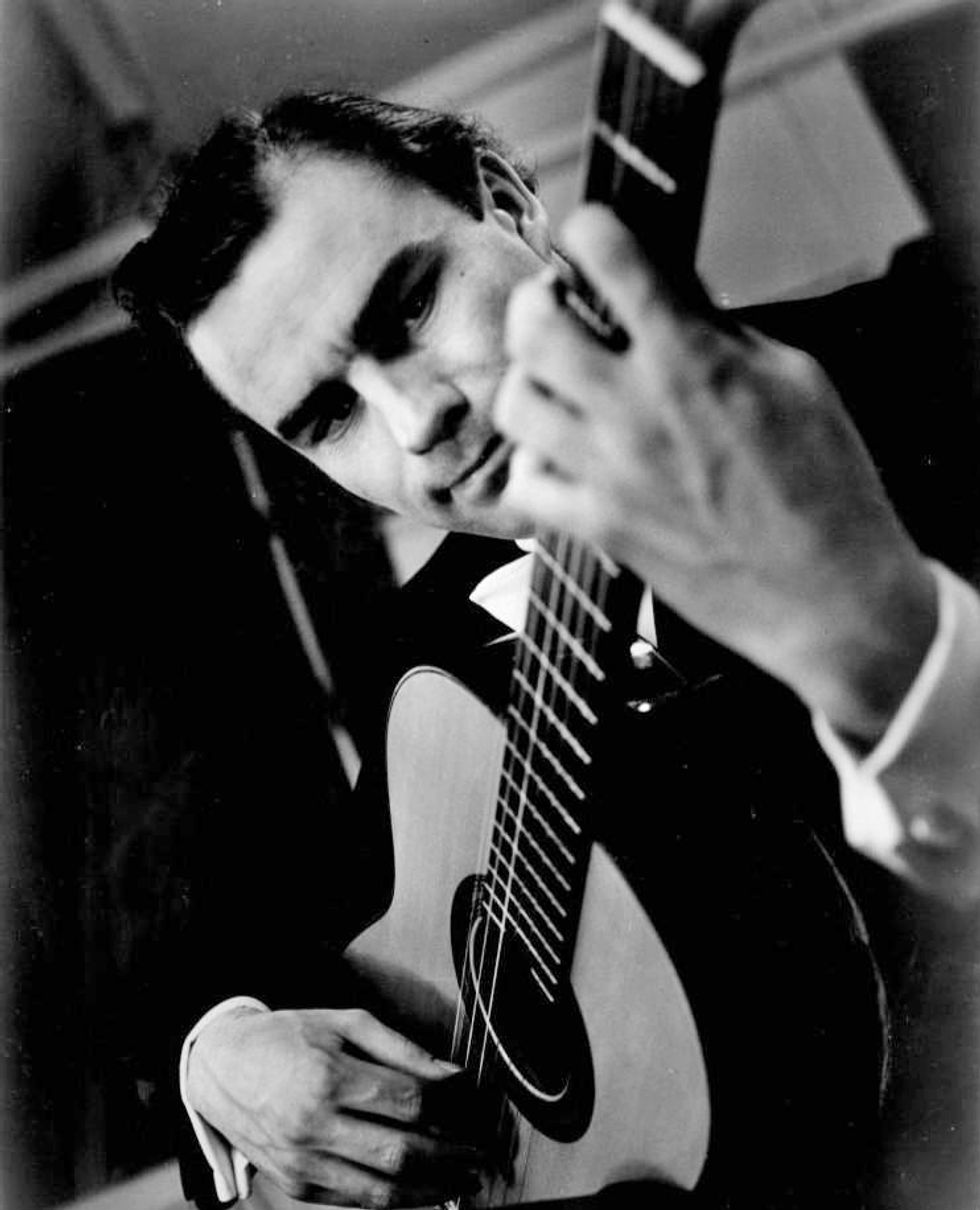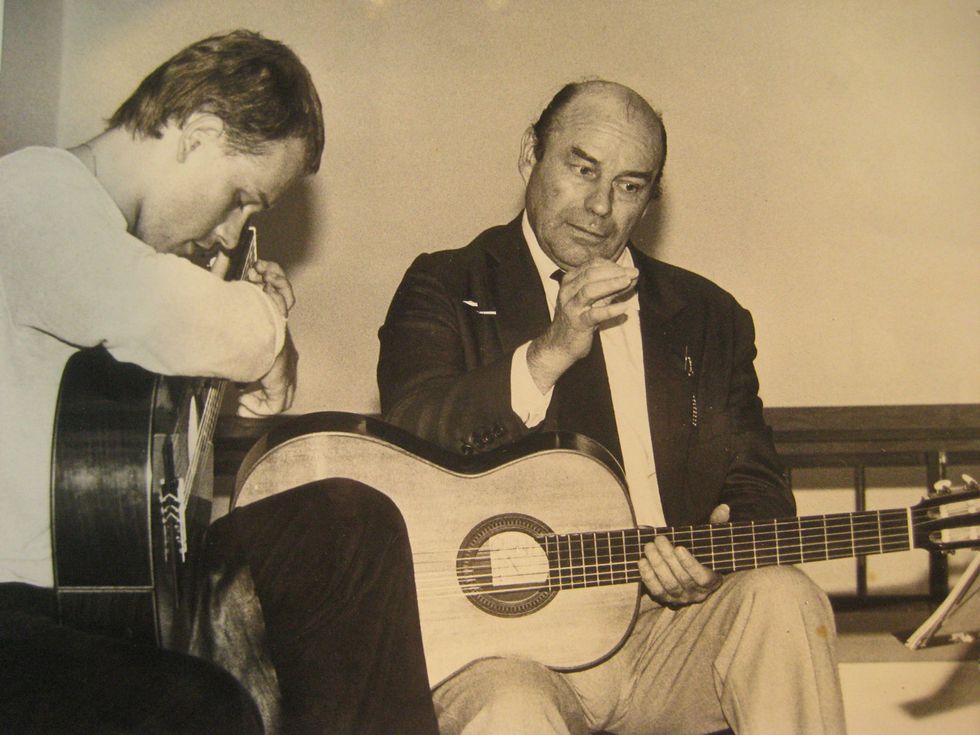As a kid growing up in Buffalo, New York, doggedly working on repertoire, English maestro Julian Bream was, more than any other guitarist, my role model as a practicing classical musician. Although I listened for hours to records by Andrés Segovia, John Williams, and Christopher Parkening (along with the new wave of guitarists like David Russell and Manuel Barrueco), I simply enjoyed Bream albums more. I really loved listening to him, and I didn’t understand why at the time. Sitting in the second row of the Buffalo Philharmonic’s Kleinhans Music Hall in 1988 for his lute/guitar recital was like sitting a few feet away from Paul McCartney. I was 14 then, and Bream was a god to me.
In spite of many advances and discoveries in technique, musicianship, and scholarship, two generations after Bream, I found that he was still the embodiment of the complete classical artist. As a young touring professional in the 1990s, I discovered that, for countless players I met everywhere, Bream was still the man.
Bream was 87 when he died at his home in Wiltshire, in the English countryside, on August 14, leaving a broad wake of influence established through roughly 100 albums, videos, and thousands of concerts during a half-century of performing. Arguably, Bream, for his wide-ranging and fluid approach and advocacy for expanding the classical-guitar repertoire, was even more important than Segovia in establishing the guitar as a serious solo instrument in the classical realm.
I must confess that back in the ’90s I had only recently recovered from a major case of Julian Bream Emulation Disease (JBED) during my teens. I was still insecure about that in my 20s. So, at that time, when answering a question from a colleague or interviewer, I was careful to name five to seven of my favorite classical guitarists in no particular order. Bream’s name was always there, but judiciously seldom topped my list.
A little context is needed here. For a time in the 1990s, it seemed the indelible fingerprints of Bream’s artistry became a little passé. His spicy and frequent use of color, liberal mix of both rest-stroke and free-stroke, elements of whimsy, fun, humor and surprise, the sense that he was inventing his interpretive ideas off-the-cuff and in the moment, etc., were not the aesthetic order of the day.
For many of the two generations of guitarists that came after Bream, there was a more conservative ideal. Now, through countless hours of personal wrangling, scholarship, and strife, we guitarists had to arrive at a “definitive” interpretation of a given piece of music. Rest-strokes were to be minimized or avoided entirely. A more clinical performance of a major work, whilst imbuing the music with stricter rhythm and time, very spare rubato, etc., was encouraged. This was probably an inevitable generational backlash to players like Segovia, Yepes, Lagoya, Presti, and, by extension, Bream. As my Cleveland Institute of Music colleague Colin Davin would say, here was an Apollonian versus a Dionysian approach.
I went through this phase myself, because as a young artist in the 1990s, I still wasn’t “all in” with the way I really wanted to play a given piece of music. Partly this was because of the great new players I met, with different and exciting (at least to me) ideas on interpretation and historical style. And remember that guitarists were steeped in scholarship relatively recently, compared to pianists and string players, and now able to earn advanced degrees almost anywhere. In the 1960s, the Peabody Institute in Baltimore was the first major conservatory in the U.S. to start a guitar department. Sharon Isbin founded the guitar department at Juilliard in 1989. Closer to home for me was inaugurating the guitar department at the Curtis Institute of Music in Philadelphia, with my colleague David Starobin, only as recently as 2011.
This also was before the full flowering of the internet, which soon would allow instant learning and emulation via easy access. Gen-Xers and older had to make do with the public library and the local record store, or if a guitarist came through your 100-mile radius, which as a kid my parents and I didn’t miss. We respected anyone with the gumption to play an entire recital from memory, on a single guitar.
So, I self-consciously wanted to do the “proper” and “definitive” service with everything to which I put my fingers and mind. Many of my favorite contemporaries also supported this approach. At the same time, more established colleagues noted that I had an “instantly recognizable sound,” what some might call a style. This made me uneasy in my 20s, because I was, in my mind, playing this music the “right” way. (The reader is welcome to have a chuckle here, and this also reminds me of the famous quote from Wanda Landowska to Pablo Casals: “You play Bach your way, and I’ll play him his way.”) So, in comparison, Bream seemed like the guitarist equivalent of Austin Powers combined with “the Dude.” He did what he wanted, and it seemed like he couldn’t care less about what a colleague or contemporary might think. Bream was the wild foil to John Williams’ more reserved scholar. This was the vibe Bream always appeared to project to me as a fan. Segovia certainly had an air of confidence, in the way he comported himself. But with Bream, it felt more natural, genuine, fun, humble, warm. In my imagination, Segovia seemed dismissive or admonishing, and Williams seemed nice but fastidious. Bream was the guy you could have a pint (or three) with at the local pub.
Of course, I never got to know any of the “Big Three.” And really, my reservations toward Bream were pure folly. In truth, he was arguably second to none as a scholar, and fiercely conscientious in his way of playing, even as he had a totally personal sound and approach. But I got older, and as the amount of my own performance material ballooned to 8-9 hours or more per concert season (plus frequent recording deadlines), my youthful reserve toward Bream faded. I gradually realized that he was the ultimate classical musician and artist, regardless of instrument. He was the main role model for me the whole time.
Julian Bream is shown here with a student in Liechtenstein in July 1985. Photo by Georg Erlich / CC BY-SA 3.0
And hey, he could comp and blow over changes on American songbook lead sheets and jazz tunes. (C’mon, he named one of his dogs Django!) Bream was hip, sophisticated, and earthy, all at once. In hindsight, he was like a guitarist from the future. He shepherded new guitar pieces by Arnold, Britten, Henze, Takemitsu, and Walton, to name a few. He played lute for the first half of many of his recitals. If half the audience left after Part 1 of Hans Werner Henze’s caustic Royal Winter Music, Bream didn’t care. That right there is as rock or punk an attitude as anything within the pop world.
Albums like Classic Guitar, Popular Classics for Spanish Guitar, 20th Century Guitar, the 1978 Villa-Lobos LP, the Granados/Albéniz, the ¡Guitarra! video series—on and on it goes. I probably listened to his Villa-Lobos Concerto every day the summer after my senior year of high school, and it was as exciting and moving to me as that year’s Public Enemy record. No phony showmanship, cheap histrionics, or careful image manipulation. Just real confidence, vitality, artistry, musicianship, and a lot of killer guitar playing. This person actually existed!
Whether it’s a musician’s responsibility to the instrument, to the audience, to the repertoire, discovering unheard works from bygone eras, exploring contemporary repertoire, balancing year after year of concert performances, recording, or following a true voice and vision—Bream did it all. One could argue that no classical guitarist has done more for the instrument and its future. The number and scope of his contributions are staggering.
Julian Bream will always be a towering giant in my mind and in my heart.












![Rig Rundown: Russian Circles’ Mike Sullivan [2025]](https://www.premierguitar.com/media-library/youtube.jpg?id=62303631&width=1245&height=700&quality=70&coordinates=0%2C0%2C0%2C0)












![Rig Rundown: AFI [2025]](https://www.premierguitar.com/media-library/youtube.jpg?id=62064741&width=1245&height=700&quality=70&coordinates=0%2C0%2C0%2C0)




















 Zach loves his Sovtek Mig 60 head, which he plays through a cab he built himself at a pipe-organ shop in Denver. Every glue joint is lined with thin leather for maximum air tightness, and it’s stocked with Celestion G12M Greenback speakers.
Zach loves his Sovtek Mig 60 head, which he plays through a cab he built himself at a pipe-organ shop in Denver. Every glue joint is lined with thin leather for maximum air tightness, and it’s stocked with Celestion G12M Greenback speakers.











